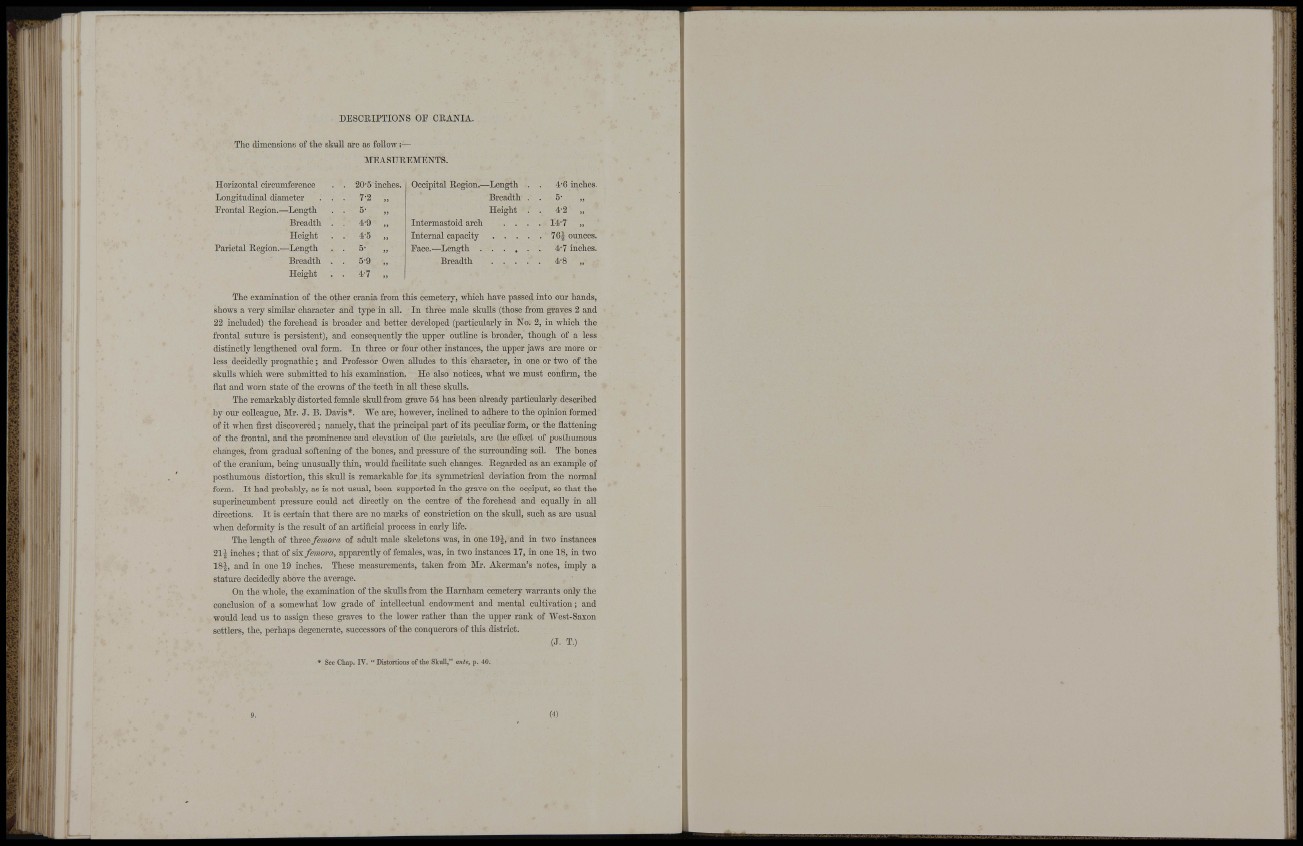
ifaf"e : i ^ I
DESCRIPTIONS OF CRANIA.
The dimensions of tlie skuU are as follow:—
MEASUREMENTS.
Horizontal circumference . 20-5 inches. Occipital Region.--Length . 4'6 inches.
Longitudinal diameter . . • 7-2 „ Breadth . . 5- „
Frontal Region.—Length • 5- Height . . 4-2 „
Breadth . • „ Intermastoid arch . 14-7 „
Height . . 4-5 „ Internal capacity . 76i ounces.
Parietal Region.—Length • 5- Eaee.—Length . • • • 4-7 inches.
Breadth . . 5-9 „ Breadth • 4-8 „
Height . • 4-7 „
The examination of the other crania from this cemetery, which have passed into our hands,
shows a very similar character and type in aU. In three male skulls (those from graves 2 and
22 included) the forehead is broader and better developed (particularly in No. 2, in which the
frontal suture is persistent), and consequently the upper outline is broader, though of a less
distinctly lengthened oval form. In three or four other instances, the upper jaws are more or
less decidedly prognathic; and Professor Owen alludes to this character, in one or two of the
skulls which were submitted to his examination. He also notices, what we must confirm, the
flat and worn state of the crowns of the teeth in all these skulls.
The remarkably distorted female skull from grave 54 has been already particularly described
by our colleague, Mr. J. B. Davis*. We are, however, inclined to adhere to the opinion formed
of it when first discovered; namely, that the principal part of its peculiar form, or the flatteniag
of the frontal, and the prominence and elevation of the parietals, are the effect of posthumous
changes, from gradual softening of the bones, and pressure of the surrounding soil. The bones
of the cranium, being unusually thin, would facilitate siich changes. Regarded as an example of
posthumous distortion, this skull is remarkable for its symmetrical deviation from the normal
form. It had probably, as is not usual, been supported in the grave on the occiput, so that the
superincumbent pressure could act directly on the centre of the forehead and equally in aU
directions. It is certain that there are no marks of constriction on the skull, such as are usual
when deformity is the result of an artificial process in early life.
The length of three/mora of adult male skeletons was, in one 19-J, and in two instances
21J inches ; that of %\s. femora, apparently of females, was, in two instances 17, in one 18, in two
and in one 19 inches. These measurements, taken from Mr. Akerman's notes, imply a
statm-e decidedly above the average.
On the whole, the examination of the skulls from the Harnham cemetery warrants only the
conclusion of a somewhat low grade of intellectual endowment and mental cultivation; and
would lead us to assign these graves to the lower rather than the upper rank of West-Saxon
settlers, the, perhaps degenerate, successors of the conquerors of this district.
(J. T.)
* See Chap. IV. "Distortions of the Skull," ante, p. 40.
'V
I
n M •
T
lilv
i ij»
l i '
u-
I
ra • : •! i
If